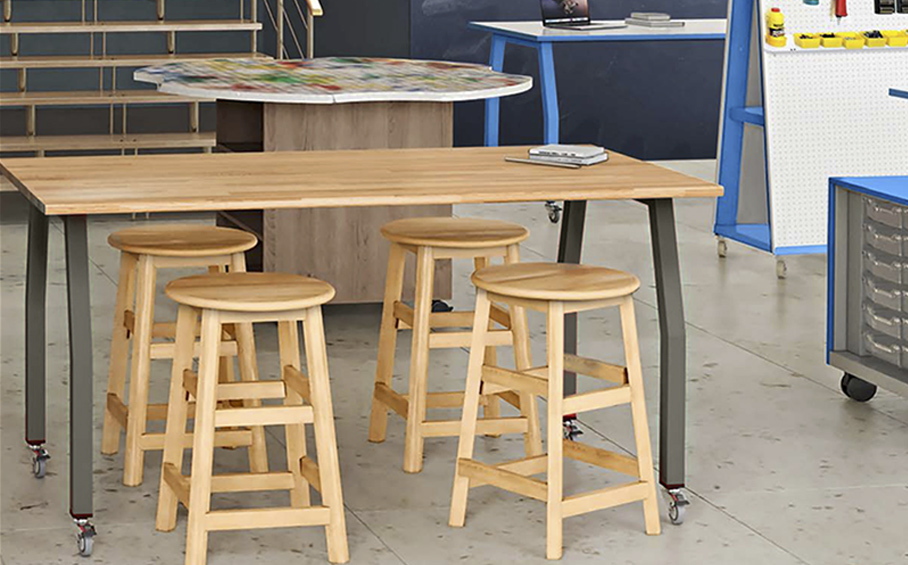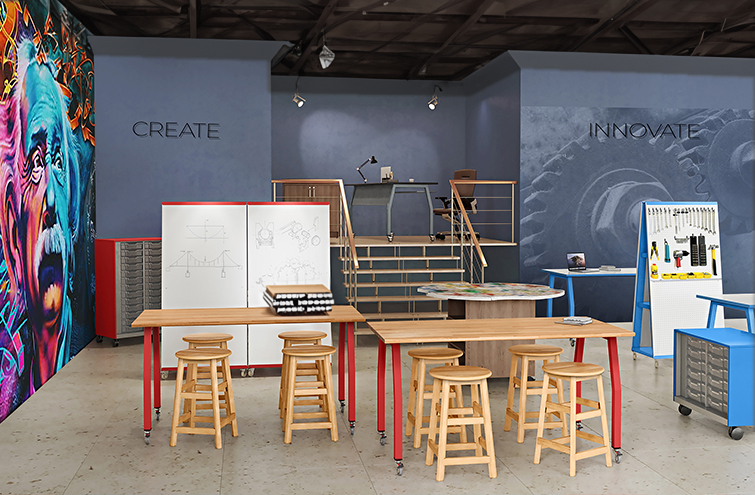In today’s rapidly evolving job market, Career and Technical Education (CTE) has become an essential component of modern education. Far from the old “vocational ed” model of the past, today’s CTE Classroom Design programs prepare students for high-demand careers with cutting-edge tools, technology, and teaching approaches. At the heart of an effective CTE program lies thoughtfully designed learning spaces equipped with specialized furniture that supports hands-on learning and skill development.
This comprehensive guide explores how strategic classroom design and purpose-built furniture solutions can elevate CTE programs across various pathways – from welding and automotive technology to culinary arts and healthcare training.
Understanding Modern CTE Learning Environments
Modern CTE education has evolved significantly from traditional vocational training. Today’s CTE classrooms are dynamic, versatile spaces designed to:
- Foster authentic, hands-on learning experiences
- Bridge academic knowledge with technical skills
- Facilitate both collaborative and individual work
- Simulate real-world workplace environments
- Accommodate specialized equipment and safety requirements
- Support multiple teaching and learning modalities
The physical environment plays a crucial role in achieving these educational objectives. By intentionally designing CTE classrooms with the right furniture, layout, and equipment, schools can create learning spaces that truly prepare students for career success.
CTE Classroom Design Essential Elements of Effective
1. Flexibility and Adaptability
CTE programs often require rapid transitions between different types of activities – from direct instruction to hands-on practice to group collaboration. Flexible classroom designs accommodate these shifts through:
- Mobile workstations and tables on casters
- Modular furniture that can be quickly reconfigured
- Multi-purpose spaces that serve various functions
- Adjustable-height surfaces for different activities
- Zones that can expand or contract based on class needs
This adaptability allows instructors to optimize the learning environment for each lesson and ensures the space remains relevant as curriculum and technology evolve.
2. Durability and Safety
CTE classrooms often subject furniture to demanding conditions – from heavy equipment to chemicals, heat, and constant use. Quality classroom furniture for these environments should feature:
- Heavy-duty construction with industrial-grade materials
- Chemical-resistant surfaces where appropriate
- Reinforced joints and stress points
- Safety features appropriate to the discipline
- Compliance with industry standards and regulations
- Easy-to-clean surfaces that maintain sanitation
Investing in durable furniture ultimately provides better value, reducing replacement costs and ensuring student safety throughout the learning process.
3. Specialized Storage Solutions
CTE programs typically utilize a wide range of tools, materials, and equipment – all of which require organized, accessible storage. Effective storage solutions include:
- Mobile tool carts and cabinets
- Locking storage for expensive equipment and hazardous materials
- Visible organization systems (clear bins, labeled drawers)
- Student project storage for works-in-progress
- Supply management systems for consumable materials
- Integrated charging stations for electronic equipment
Strategic storage solutions improve classroom efficiency, reduce material waste, and teach students professional organization habits they’ll need in the workplace.
4. Technology Integration
Modern CTE programs rely heavily on technology, requiring furniture designed to support digital learning tools. Key considerations include:
- Abundant and accessible power sources
- Cable management systems
- Device charging and storage options
- Display mounting capabilities
- Networking infrastructure access points
- Workstations designed for computer/device use alongside hands-on work
Well-designed technology integration creates a seamless learning experience and prepares students for increasingly digital workplaces.
Specialized Furniture for Common CTE Pathways
Different CTE pathways have unique requirements for their learning environments. Here’s a breakdown of specialized furniture considerations for some popular pathways:
Welding and Metal Fabrication
Welding classrooms need furniture designed for high heat, sparks, and heavy materials. Essential components include:
- Heavy-duty welding booths with proper ventilation
- Welding tables with fire-resistant surfaces
- Industrial stools at appropriate heights
- Heat-resistant storage cabinets
- Material handling carts and racks
- Dedicated cleaning stations
The classroom layout should include clearly defined safety zones, adequate spacing between workstations, and efficient material flow patterns.
Automotive Technology
Automotive programs require spaces that accommodate vehicle access and specialized equipment. Key furniture elements include:
- Vehicle lifting systems (full lifts or portable jacks)
- Tool storage systems and carts
- Heavy-duty workbenches for engine work
- Mobile creepers and stools
- Parts washing stations
- Computer diagnostic workstations
The design should balance hands-on work areas with classroom space for theoretical instruction and computer-based diagnostics.
Culinary Arts
Culinary classrooms should mirror professional kitchens while supporting instructional needs. Important components include:
- Professional-grade cooking stations with ventilation
- Food preparation tables at ergonomic heights
- Sanitation stations and hand-washing facilities
- Ingredient and utensil storage systems
- Demonstration areas with good visibility
- Flexible dining/service areas
The layout should facilitate the natural flow of food preparation from storage to prep to cooking to service, while allowing instructor supervision throughout.
Healthcare and Medical Sciences
Healthcare training requires specialized simulation environments. Furniture considerations include:
- Hospital bed stations with privacy provisions
- Clinical procedure simulation areas
- Anatomical model storage and display
- Sanitation and sterilization stations
- Medical equipment storage
- Classroom/theory instruction space
The environment should balance clinical realism with educational accessibility, allowing students to develop practical skills in a controlled setting.
Information Technology and Computer Sciences
IT classrooms need furniture designed for extensive computer use while supporting collaborative projects. Key elements include:
- Ergonomic computer workstations with adjustable components
- Collaborative spaces for team programming
- Server and networking equipment racks
- Cable management solutions
- Hardware testing and repair benches
- Project development and testing areas
The design should allow for both focused individual work and group collaboration on larger projects.
Creating Zones Within CTE Classrooms
Effective CTE classroom design often incorporates distinct functional zones that support different aspects of learning:
1. Direct Instruction Zone
This area supports teacher-led instruction with:
- Clear sightlines to presentation screens or demonstrations
- Comfortable seating for note-taking
- Whiteboard or digital display visibility
- Good acoustics for instruction
2. Hands-on Practice Zone
This zone enables skill development through:
- Specialized workstations for the relevant discipline
- Adequate space around equipment for safety
- Access to necessary tools and materials
- Appropriate safety equipment readily available
3. Collaboration Zone
This area facilitates teamwork with:
- Group seating arrangements
- Writable surfaces for planning and brainstorming
- Shared display capabilities
- Acoustic considerations to manage group discussion noise
4. Planning and Design Zone
This space supports project development through:
- Research resources (digital or physical)
- Design tools and software
- Project planning materials
- Prototype development supplies
5. Reflection and Assessment Zone
This area enables evaluation and improvement through:
- Space for project display and critique
- Documentation tools for portfolio development
- Self-assessment resources
- Peer review facilitation
By intentionally designing these zones, CTE classrooms can support the complete learning cycle – from initial instruction through practice, collaboration, planning, and reflection.
Furniture Selection Guidelines
When selecting furniture for CTE classrooms, consider these important factors:
Material Selection
Choose materials appropriate for the specific discipline:
- Metal surfaces for heat resistance in welding shops
- Chemical-resistant surfaces for science or healthcare
- Food-safe materials for culinary arts
- Impact-resistant edges for high-activity environments
- Anti-static properties for electronics work
Ergonomics and Safety
Prioritize student comfort and safety:
- Adjustable-height options for diverse student needs
- Standing-height options for appropriate activities
- Proper support for extended work periods
- Smooth edges and corners in high-movement areas
- Stability for equipment-supporting furniture
Mobility and Storage
Enhance flexibility through thoughtful features:
- Locking casters on appropriate pieces
- Integrated storage in workstations
- Nestable or Flip Top table options for occasional use
- Weight capacity appropriate for intended use
- Accessible storage at point-of-use locations
Conclusion: Investing in Student Success
Thoughtfully designed CTE classrooms with appropriate, specialized furniture represent an investment in student success. These learning environments do more than house equipment – they actively contribute to skill development, safety awareness, and professional mindset formation.
As CTE continues to evolve, classroom design must keep pace with industry changes, educational approaches, and student needs. By creating flexible, durable, and authentic learning spaces, schools can ensure their CTE programs truly prepare students for career success.
The most effective CTE classrooms seamlessly blend form and function – supporting both the practical requirements of technical education and the pedagogical needs of effective instruction. When furniture and layout work in harmony with curriculum and teaching, students gain not just technical skills but also the professional habits and mindsets that lead to long-term career success.
Allied USA School Furniture specializes in designing and manufacturing innovative furniture solutions for Career and Technical Education environments. Contact our CTE design specialists to explore custom solutions for your program’s unique needs.
Sources:
- Association for Career and Technical Education (ACTE): https://www.acteonline.org/
- Advance CTE: https://careertech.org/
- National Center for Construction Education and Research (NCCER): https://www.nccer.org/
- National Science Foundation’s Advanced Technological Education (ATE) program: https://www.nsf.gov/funding/pgm_summ.jsp?pims_id=5464
- Career and Technical Education Journal: https://www.acteonline.org/publications/techniques/
- American Culinary Federation Education Foundation: https://www.acfchefs.org/ACF/Education/Accreditation/
- American Welding Society: https://www.aws.org/education/
- National Automotive Technicians Education Foundation (NATEF): https://aseeducationfoundation.org/
- EdSurge: https://www.edsurge.com/
- Department of Education’s Office of Career, Technical, and Adult Education (OCTAE): https://www2.ed.gov/about/offices/list/ovae/index.html
- Edutopia: https://www.edutopia.org/








